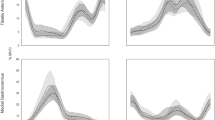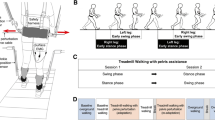Abstract
Backward walking (BW), an emerging rehabilitative and training modality, was integrated with unstable sole construction with various hardness levels to analyze the kinematic and kinetic characteristics of the lower extremities. Eighteen participants volunteered to participate in the test. They performed walking tests under three conditions: (1) BW with normal shoes (NBW); (2) BW with unstable shoes with soft unstable elements (UBW-S); (3) BW with unstable shoes with hard unstable elements (UBW-H). The results show increased hip and ankle flexion and increased knee flexion–extension extent in the stance phase during BW with unstable shoes. The motor control mechanism of unstable BW enhanced the rehabilitation of lower limb deficiency. The attached unstable elements (UBW-S and UBW-H) induced local perturbation to stimulate proprioceptive ability and the neuromuscular system, changing the plantar loading distribution in a certain region. Future study should concentrate on the possible rehabilitative effect of unstable BW on neurological disorders and motor system deficiency.





Similar content being viewed by others
References
Lee, M., Kim, K., Son, J., & Kim, Y. (2013). Kinematic and kinetic analysis during forward and backward walking. Gait & Posture, 38(4), 674–678.
Armstrong, C. W., Commager, J. M., and Woolley, S. (1989) “A comparative analysis of forward and backward walking”. In: Proceedings of the 6th annual East Coast clinical gait conference, Lansing, MI, vol. 989, pp. 98–70.
Thorstensson, A. (1986). How is the normal locomotor program modified to produce backward walking? Experimental Brain Research, 61(3), 664–668.
Van Deursen, R. W. M., Flynn, T. W., McCrory, J. L., & Morag, E. (1998). Does a single control mechanism exist for both forward and backward walking? Gait & Posture, 7(3), 214–224.
Yang, Y. R., Yen, J. G., Wang, R. Y., Yen, L. L., & Lieu, F. K. (2005). Gait outcomes after additional backward walking training in patients with stroke: A randomized controlled trial. Clinical Rehabilitation, 19(3), 264–273.
Itoh, C., Kasai, T., & Wakayama, S. (2015). Comparison of forward and backward walking in gait initiation. Physiotherapy, 101(1), e660.
Rose, D. K., & DeMark, L. (2013). Backward walking training to improve mobility in acute stroke: A pilot study. Archives of Physical Medicine and Rehabilitation, 94(10), 36.
Kramer, J. F., & Reid, D. C. (1981). Backward walking: A cinematographic and electromyographic pilot study. Physiother, 33(2), 77–86.
Huang, H., Chen, C., Chang, J., Guo, L., Lin, H., & Wu, W. (2008). Quantitative gait analysis after unilateral knee arthroplasty for patients with bilateral knee osteoarthritis. Journal of Medical and Biological Engineering, 28(1), 11–16.
Mackie, J. W., & Dean, T. E. (1984). Running backward training effects on upper leg musculature and ligamentous instability of injured knees. Medicine and Science in Sports and Exercise, 16(2), 151.
Thelkeld, A. J., Horn, T. S., Wojtowicz, G. M., Rooney, J. G., & Shapiro, R. (1989). Kinematics, ground reaction force, and muscle balance produced by backward running. Journal of Orthopaedic and Sports Physical Therapy, 11(2), 56–63.
Zhang, X., Zhang, Y., Gao, X., Wu, J., Jiao, X., Zhao, J., et al. (2014). Investigating the role of backward walking therapy in alleviating plantar pressure of patients with diabetic peripheral neuropathy. Archives of Physical Medicine and Rehabilitation, 95(5), 832–839.
Fitzgerald, G. K., Childs, J. D., & Ridge, T. M. (2002). Agility and perturbation training for a physically active individual with knee osteoarthritis. Physical Therapy, 82(4), 372–382.
Vilensky, J. A., Gankiewicz, E., & Gehlsen, G. (1987). Kinematic comparison of backward and forward walking in humans. Journal of Human Movement Studies, 13, 29–50.
Muddasir, A., & Nanda, K. T. R. (2009). The effect of backward walking treadmill training on kinematics of the trunk and lower limbs. Serbian Journal of Sports Sciences, 3, 121–127.
Kutzner, I., Stephan, D., Dymke, J., Bender, A., Graichen, F., & Bergmann, G. (2013). The influence of footwear on knee joint loading during walking-in vivo load measurements with instrumented knee implants. Journal of Biomechanics, 46(4), 796–800.
Gu, Y., Lu, Y., Mei, Q., Li, J., & Ren, J. (2014). Effects of different unstable sole construction on kinematics and muscle activity of lower limb. Human Movement Science, 36, 46–57.
Amir, H., Nimrod, R., & Alon, W. (2010). The influence of sagittal center of pressure offset on gait kinematics and kinetics. Journal of Biomechanics, 43, 969–977.
Chang, L., Su, F., Lai, K., & Tsai, K. (2005). Gait analysis after shoe lifts in adults with unilateral developmental dysplasia of the hip. Journal of Medical and Biological Engineering, 25(3), 137–141.
Nigg, B. (2009). Biomechanical considerations on barefoot movement and barefoot shoe concepts. Footwear Science, 1, 73–79.
Stöggl, T., Haudum, A., Birklbauer, J., Murrer, M., & Müller, E. (2010). “Short and long term adaptation of variability during walking using unstable (Mbt) shoes”. Clinical Biomechanics, 25, 816–822.
Turbanski, S., Lohrer, H., Nauck, T., & Schmidtbleicher, D. (2011). Training effects of two different unstable shoe constructions on postural control in static and dynamic testing situations. Physical Therapy in Sport, 12, 80–86.
Grasso, R., Bianchi, L., & Lacquaniti, F. (1998). Motor patterns for human gait: Backward versus forward locomotion. Journal of Neurophysiology, 80, 1868–1885.
Papalia, R., Di Pino, G., Tecame, A., Vadala`, G., Formica, D., Di Martino, A., et al. (2015). “Biomechanical and neural changes evaluation induced by prolonged use of non-stable footwear: A systematic review”. Musculoskeletal Surgery, 11, 1–5.
Van Engelen, S., Wajer, Q. E., & Van der Plaat, L. W. (2010). Metabolic cost and mechanical work during walking after tibiotalar arthrodesis and the influence of footwear. Clinical Biomechanics, 25(8), 809–815.
Nigg, B. M., Emery, C., & Hiemstra, L. A. (2006). Unstable shoe construction and reduction of pain in osteoarthritis patients. Medicine and Science in Sports and Exercise, 38(10), 1701–1708.
Mei, Q., Feng, N., Ren, X., Lake, M., & Gu, Y. (2015). Foot loading patterns with different unstable soles structure. Journal of Mechanics in Medicine and Biology, 15(1), 1550014.
Li, F., Mei, Q., & Gu, Y. (2015). Effects of unstable elements with different hardness on lower limb loading. Acta of Bioengineering and Biomechanics, 17(2), 85–92.
Debbi, E. M., Wolf, A., & Haim, A. (2012). Detecting and quantifying global instability during a dynamic task using kinetic and kinematic gait parameters. Journal of Biomechanics, 45(8), 1366–1371.
Brian, H., & Arnold, B. (2013). Effects of toning shoes on lower extremity gait biomechanics. Clinical Biomechanics, 28(3), 344–349.
Nigg, B., Hintzen, S., & Ferber, R. (2006). Effect of an unstable shoe construction on lower extremity gait characteristics. Clinical Biomechanics, 21(1), 82–88.
Zhang, M., Liu, A., & Jiang, L. (2015). The biomechanical effects of backward walking on the knee: A new method for releasing the joint loading. Osteoarthritis and Cartilage, 23, A121–A122.
Dufek, J., House, A., & Mangus, B. (2011). Backward walking: A possible active exercise for low back pain reduction and enhanced function in athletes. Journal of Exercise Physiology, 14, 17–26.
Poosapadi Arjunan, S., Kumar, D., Poon, W., Rudolph, H., & Hu, Y. (2010). Variability in surface electromyogram during gait analysis of low back pain patients. Journal of Medical and Biological Engineering, 30(3), 133–138.
Flynn, T. W., & Soutas-Little, R. W. (1995). Patellofemoral joint compressive forces in forward and backward running. Journal of Orthopaedic and Sports Physical Therapy, 21(5), 277–282.
Stewart, L., Gibson, J. N. A., & Thomson, C. E. (2007). In-shoe pressure distribution in “unstable” (MBT) shoes and flat-bottomed training shoes: A comparative study. Gait & Posture, 26(4), 648–651.
Acknowledgments
This study sponsored by Zhejiang Social Science Program ‘Zhi Jiang youth project’ (16ZJQN021YB), National Natural Science Foundation of China (81301600), K. C. Wong Magna Fund in Ningbo University, National Social Science Foundation of China (16BTY085), and Anta Sports Products Limited.
Author information
Authors and Affiliations
Corresponding author
Rights and permissions
About this article
Cite this article
Shu, Y., Gu, Y., Mei, Q. et al. Movement Analysis of Lower Limb During Backward Walking with Unstable Intervention. J. Med. Biol. Eng. 36, 718–725 (2016). https://doi.org/10.1007/s40846-016-0166-4
Received:
Accepted:
Published:
Issue Date:
DOI: https://doi.org/10.1007/s40846-016-0166-4




